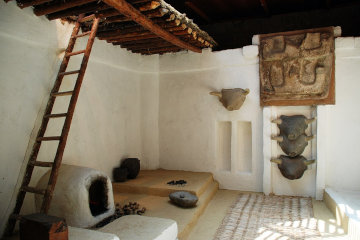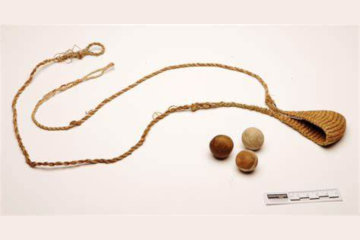Long Range or Short?
Many years ago I was reading a psychology text book and was fascinated by the various experiments that have been carried out over the years. There was the notorious Stanford Prison Experiment, when volunteers were assigned at random to be either prisoners or guards. With horrifying ease the guards were manipulated into regarding the "prisoners" as almost sub-human and started to mistreat them. Another experiment had divinity school students being asked to give a talk on the subject of the Good Samaritan. On their way to the studio where the talk was to be recorded, they encountered an actor lying on the ground and pretending to be in pain. Most of them ignored him - they were in the hurry to get to the studio - and one or two even stepped over him and carried on their way.
There was one experiment that I found even more interesting than these. The researchers took a family of rats and confined them into a reasonable size enclosure. They were given adequate food and drink and were allowed to breed and multiply. Within a short time - rats are alarmingly fecund - the enclosure became overcrowded and the result was a breakdown in rat society. Gangs of young rats rampaged about the place, raping females and terrorising the elderly. There was an unexplained increase in homosexual behaviour and shocking cases of infanticide.
I forget how the experiment was brought to an end - whether the whole thing was shut down and the rats killed painlessly or whether sufficient rats were killed to bring the overcrowding to an end, but the purpose of the experiment was to see what happens when a population becomes overcrowded. It was implied that analogous behaviours emerge with human populations that are overcrowded, though of course with humans the situation is usually exacerbated by a shortage of resources resulting in poverty and hunger.
Even back then, nearly half a century ago, it was becoming clear that some of the results of the rat experiment were indeed being replicated in inner-city neighbourhoods. Gangs of youths engaged in anti-social behaviours - including rape - and homosexual behaviour was on the increase.
Excavations in Turkey have shown that the problem does not lie with Twenty-first Century youth or the agony of not being able to afford the latest i-Pad, but rather it is humans themselves who are the problem.
Catal Hoyuk is a Neolithic city in southern Turkey which astonished excavators when it was first discovered. At the time the scientific consensus, influenced by evolutionary theory, tended to regard the Neolithic as only a couple of steps removed from the great apes. To find that these same Neolithic people practised agriculture and were capable of building a large city with elaborately decorated rooms was somewhat of a shock. Indeed, it is not too much to say that Catal Hoyuk forced a radical re-think of the Neolithic!

| |
| James Mellaart, the man who first excavated Catal Hoyuk. |
The site was first excavated by James Mellaart in 1958 but though he was a careful archaeologist, he did not have the range of techniques which are now available. From that point of view, it was perhaps fortunate that Mellaart was banned from Turkey over the Dorak Affair. Excavations did not begin again until 1993 when Ian Hodder of the University of Cambridge took up the task.
Over the past twenty-five years, an international team of bio-archaeologists has been examing the skeletons found in the ruins of Catal Hoyuk, a total of 740. They have discovered that about 25% of the skulls showed signs of trauma - in particular, they have showed healing from what the team interpret as damage caused by small projectiles. About a dozen of the skulls showed more than one episode of damage and healing.
The team suggest that the damage could have been caused by small clay balls hurled from slings and they suggest that this is evidence of inter-personal violence due to overcrowding.

| |
| The interior of a typical house in Catal Hoyuk. Notice the ladder which gave access to the roof. |
As additional evidence, about a third of the skeletons showed evidence of deep-seated infection in the bones, which is also interpreted as evidence of overcrowding. Dwellings were stacked on top of each other and many rooms had to be entered via a ladder through a hole in the roof. The plaster in some rooms was stained with what turned out to be faeces, both human and animal. Although we may doubt that people in these stacked up dwellings persuaded their cows and horses to climb ladders in and out of the rooms, cats and dogs are a different matter and it is not beyond possibility that goats and lambs may also have lived with their owners.
In addition, most of the houses had rubbish dumps in close proximity. Rubbish dumps are the archaeologists' delight, because there you will find a treasure trove of discarded objects. Broken pots - which give you a chronology of the location - were swept up by tidy housewives, so only rarely are they found inside houses. Instead the sherds were taken out and discarded on the rubbish dump for archaeologists to find. Lamps, pots, drinking vessels, storage jars (amphorae in later periods) and so on, are all to be found on the dump, not in the houses.
However while archaeologists delight in them, so did ancient germs and having a rubbish dump outside your door cannot have contributed to household hygiene, which was already shaky due to a lack of toilet facilities for both humans and animals!
However these overcrowded houses do call into question the clay ball and slings idea. I am not an expert in skull fractures, but I have seen clay balls - rough clods, usually - hurled from slings and can testify that they shatter on impact. I have no doubt that they would give you a nasty headache, but whether they would result in a skull fracture is another matter.

| |
| An Egyptian sling and three clay balls, from the Manchester Museum. |
More to the point is the fact that a sling requires room. A sling consists of a length of string or leather thong which, when doubled, is between two and three feet long. In the middle of the string is a shallow pouch and one end of the string is longer than the other. You wind the long end around your middle finger, place the stone or clay ball in the pouch, then hold the end of the short string between thumb and forefinger.
The next step is to whirl the string around your head, as if it was the blades of a helicopter and you were trying to take off. Even if you could keep your arm still you would still need an area four to six feet in diameter, but in fact you have to add arm movement to the required area, which would involve at least another foot and more likely two or three - a circle seven to nine feet in diameter. Finally you release the short end of the string, which frees the stone from its pouch and sends it flying for a considerable distance.
A sling is not a short-range weapon and unless the inhabitants of Catal Hoyuk stood on their rooftops slinging stones at one another, I gravely doubt if a sling would be the weapon of choice in the narrow, crooked alleys that passed for city streets in those days! (In fact, there were no streets in Catal Hoyuk and it was the roofs which gave access to the various houses.)

| |
| Assyrian slingers from the Lachish reliefs. Although they appear to be whirling their slings vertically, I would put that down to the artists' ignorance about perspective! |
The Bible speaks of men from the tribe of Benjamin who could sling at a hairsbreadth and not miss, but such an accomplishment must have been fairly rare - rare enough to be worthy of comment - and pulling off head-shots with a sling was quite a feat. David might do it when confronted with Goliath, but to think that a quarter of the city's inhabitants might be so skilled - unless, of course, there was a mass murderer on the loose in Catal Hoyuk - is perhaps being a bit too optimistic.
Although the people of Catal Hoyuk did engage in some agriculture (or at least, in plant-gathering), the evidence seems to indicate that they principally relied on flocks of sheep. Despite the eulogies of sheep farmers here in Wales, sheep are contrary beasts - and pretty nippy on their feet as well. Welsh sheep farmers rely on their trained sheep-dogs to round up their flocks, but out in the Middle East I have seen shepherds retrieving a straying sheep by slinging clods of earth, which hit the ground on one side of the sheep and burst, scaring the sheep into going in the opposite direction.

| |
| An Indian boy from Ladakh using a sling to drive his sheep along. |
If we can imagine boys and teenage youths setting out in the morning with the family sheep, all jumbled together, all shouting and yelling, and all slinging clods of earth or small stones at errant sheep, I believe you have a more likely scenario for the skull fractures. If you are focussed on herding a straying sheep you may not notice your neighbouring shepherd dashing into your line of fire in pursuit of his own errant lamb!
Does that disprove the inter-personal violence scenario? Not necessarily. When you have as many as 10,000 individuals crammed into twelve hectares, along with their animals, and often living literally on top of one another, it is almost certain that there would be disagreements between neighbours and, human nature being what it is, some of those disagreements would involve a degree of physical violence. But with slings?
==========
Dorak Affair Mellaart was travelling by train when he encountered a young lady who showed him some remarkable gold objects. Mellaart sketched them and later published his sketches, but the objects themselves - along with the young lady - disappeared. It was suspected that Mellaart had encountered a sophisticated criminal enterprise in which he was used to provide authentication for the objects which were then sold on the black market to illegal collectors.
The situation is further complicated by the fact that after Mellaart's death it was discovered that he had, in fact, forged some of the things he claimed to have discovered at Catal Hoyuk. No one is sure of his motive except that it does seem that the forgeries were in support of his theories about mother goddess cults and the Luwian culture (he invented the term "Luwian"). Return
© Kendall K. Down 2019





